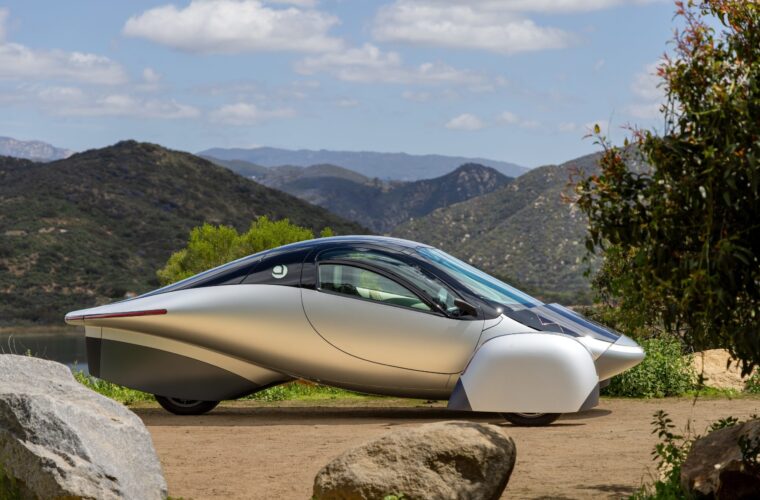Electric powered vehicles are a crucial piece of the net zero puzzle, but meeting the bar set by their carbon-guzzling cousins is no mean feat. Some manufacturers are betting on solar power to solve many of the technology’s teething troubles.
Not yet being the norm, electric powered vehicles suffer from a few major roadblocks to broad acceptance. Range anxiety was the earliest among these. Many e-vehicle owners had concerns when travelling distances beyond a simple commute that the battery charge would not be sufficient to reach their destination. This caused some reluctance among drivers to adopt e-vehicles.
The need to stop for up to a few hours to recharge at a power station is the latest technical hurdle.
Models on the market possess wildly different charging technologies and requirements. Some take less than an hour to “fill up”, others much longer. Certain models can adapt to the full range of power supplies on offer, while others are more selective and need onboard conversion tools.
Battery technology and vehicle efficiency have ramped up in recent years, however. Tesla’s crown as the only manufacturer offering more than 400km in driving range is no longer uncontested. Audi and Mercedes-Benz both offer models with ranges topping 417 km. Hyundai also entered the race with the Kona Electric and its larger battery option stretching its legs to 449 km.
Even still, driving range and charging capabilities are sticking points that cause many drivers to think twice about taking the leap to electric. But what if the car did not need costly power converters or the overnight stay to reach maximum charge?
What if it could simply harness the sun?
Solar has come a long way
Several manufacturers are looking at solar power as the antidote to the e-revolution’s most dogged issues. The Dutch company Lightyear has plans to start production of its Lightyear One in 2021, coming off the back of a prototype reveal and pre-order push in 2019.
The smooth and glossy Lightyear One will be one of the world’s first solar-powered family cars. It has space inside for five people, with 5m2 of solar charging panels on its roof. The company claims 40% of the vehicle’s yearly mileage can be powered by the sun.
In an hour, the Lightyear One can also charge up to 507km worth of power with 60kW fast charging. On conventional 230V household power supply, it takes a while longer, reaching 400km capacity after overnight charging. The solar panels also power the car as it is moving, giving the engine a boost.
The main goal of the car is to raise up where electric cars fall short, according to Lightyear’s CEO and co-founder Lex Hoefsloot.



“Research has shown that range and the lack of charging options are still the top concerns that people have when considering electric cars,” Hoefsloot explains, adding that the company wanted to offer one of the most sustainable cars on the market that, at the same time, is convenient to run and charge.
The €150,000 price tag means that this model is out of reach for most people, but Hoefsloot is confident prices will fall as the technology becomes more widely adopted.
“Since new technology has a high unit cost, we have to start in an exclusive market […] The next models we plan to develop will have a significantly lower purchase price,” the CEO says.
Future models will also operate within autonomous and shared car fleets, and this scale will positively impact purchase price in the coming years, he adds.
Coming down to Earth
If Lightyear’s offering is too rich for you, Germany’s Sono Motors might be worth considering.
The company markets its Sion as the first truly affordable solar electric car. The nifty and practical entry to the e-market can manage around 34km on solar power alone. When that is not enough, the Sion taps its 255km battery capacity. Compact and functional, the car’s exterior bristles with solar cells.
While the range and aesthetic do not match that of premium vehicles, nor does the cost to own it.
The Sion starts at €25,500 and will reach production in 2023. The Swedish-German city mover is cheaper than almost any of its competitors, in more ways than one.


“Here we also have one of the lowest total costs of ownership in the segment […] imagine being able to own and operate this vehicle for five years and save thousands of dollars in fuel costs,” Sono Motors COO Thomas Hausch explained during this year’s CES2021.
If these first two seemed a little futuristic, they have nothing on US-based Aptera Motors.
The three-wheeled, teardrop-sleek “never charge” solar electric vehicle has room enough for two and a maximum speed of 177km/hr. Its aerodynamic body and lightweight design also maximise energy efficiency. The Aptera technically falls somewhere outside the definition of “car,” but this only enhances its performance and range.
In fact, the company claims that most users will never need to charge their vehicle at all, as its 180 solar cells will get it almost 18,000km per year from solar energy alone.


The Aptera will set you back $25,500 (€20,900) with first production scheduled this year.
In February, the company raised $4 million (€3.2 million) in series A funding, as well as securing 7000 reservations for the vehicle — reportedly amounting to a cool quarter billion.
If the Aptera is any indication, the electric/solar car market is set for an abundance of diversity in the coming years with manufacturers giving themselves license to take a little more risk.
Existing household names such Hyundai and Toyota have also started offering solar panel options with their e-vehicles, and Tesla’s Elon Musk has discussed adding a similar option to future configurations of the company’s Cybertruck.

